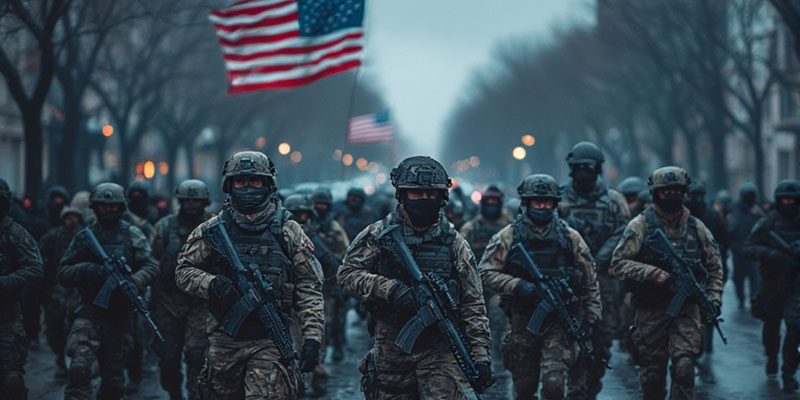Terrorism is a word used often and with moral certainty—almost always to describe non-state actors who commit violence against civilians to achieve political goals. Yet when that same framework is applied to powerful nation-states, the conversation quickly becomes uncomfortable. By the widely accepted definition—”the use of violence or the threat of violence by a state to instill fear and control populations, often for political purposes”—the United States federal government’s actions at home and abroad raise troubling questions about what qualifies as terrorism, and who gets to define it.
The 2003 invasion of Iraq, carried out under the pretense of eliminating weapons of mass destruction that were never found, led to catastrophic human suffering. Estimates of civilian deaths range from several hundred thousand to over a million. Entire cities were reduced to rubble, infrastructure collapsed, and sectarian violence, once marginal, spiraled into a global crisis with the emergence of ISIS. This was not incidental damage—it was the predictable result of a war launched not in self-defense, but to project power, realign a region, and instill political compliance, both abroad and at home.
Today, the United States is a central backer of Israel’s military campaign in Gaza, supplying weapons, munitions, and billions of dollars in aid, while shielding the country diplomatically at the United Nations. Tens of thousands of civilians have been killed, many of them women and children, in densely populated urban areas where no safe zone exists. Critics, including major human rights organizations, have described Israel’s actions as disproportionate and possibly criminal. The United States, far from being a neutral party, continues to enable this campaign with lethal support and diplomatic impunity. If terrorism is defined by instilling fear to achieve political outcomes, then the weapons provided, the vetoes cast, and the silence maintained are not outside that framework.
This pattern is hardly new. In 1953, the U.S. orchestrated a coup in Iran to remove a democratically elected prime minister whose policies threatened Western oil interests. In the decades that followed, Washington supported brutal regimes and violent coups across Latin America—from Chile to Guatemala to Argentina—leaving behind decades of repression, torture, and mass death. These were not random missteps; they were deliberate interventions designed to prevent popular movements from threatening U.S. influence or economic control. In each case, violence was used—or funded or trained—to force compliance.
During the Cold War and beyond, U.S. military interventions in Korea, Vietnam, and elsewhere unleashed devastating bombing campaigns. In Vietnam alone, an estimated two to three million people were killed, and the effects of chemical weapons like Agent Orange persist to this day. The Korean War produced similar carnage. These wars, carried out to contain communism and uphold geopolitical dominance, did not just target military adversaries; civilians were caught in—and often directly subjected to—the machinery of state-directed terror.
The advent of drone warfare has brought this strategy into the 21st century, with the U.S. executing thousands of targeted killings in countries like Pakistan, Yemen, and Somalia—often without any formal declaration of war. These strikes have killed civilians, including children, and created a constant threat from the sky that looms over communities for years. The psychological and social toll is immense. Even American citizens have been killed in these operations without due process. These are not just military actions—they are instruments of fear and control, precisely what terrorism aims to achieve.
Economic violence is another, often overlooked, tool. U.S.-led sanctions on countries like Venezuela, Iran, and Cuba have restricted access to food, medicine, and fuel, often with devastating consequences for civilian populations. These sanctions are usually framed as peaceful alternatives to war, but their effects are anything but benign. They punish entire societies, not regimes, and do so for the purpose of forcing political change—exactly the logic that underpins terrorism.
At home, the federal government has surveilled, infiltrated, and repressed dissent for generations, from COINTELPRO’s targeting of civil rights leaders to today’s mass surveillance apparatus. Whistleblowers and journalists who expose state wrongdoing have faced draconian punishment. These are tools of coercion, not democracy.
Taken together, the U.S. government’s pattern of behavior—global in reach, generational in duration, and enormous in scale—calls for a reexamination of the word “terrorism” itself. If terrorism is about the use of violence to create fear and achieve political outcomes, then drone strikes, military invasions, support for brutal regimes, and the slow violence of sanctions all qualify. The difference is not in the method or the motive—it is in the power to define the terms and control the narrative.
The label of “terrorist organization” carries weight. It is used to justify wars, surveillance, censorship, and extraordinary measures. But if the term is to have any real meaning, it must be applied consistently—even, or especially, to the most powerful actors on the global stage.
Calling the U.S. government the world’s largest terrorist organization is a provocative assertion. But it is not made lightly. It is made in the interest of moral clarity, of exposing the violence that is too often sanitized by euphemism and concealed behind the veil of democratic ideals. Terrorism is not only the work of extremists in the shadows. Sometimes, it is planned in boardrooms, drafted in legal memos, and executed with a presidential signature.
